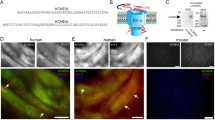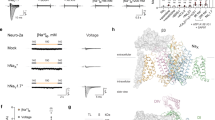Abstract.
Nucleotide-dependent gating of ΔF508-CFTR was evaluated in membrane patches excised from HEK 293 and mouse L-cells and compared to observations on wt-CFTR channels recorded in the same expression systems. ΔF508-CFTR exhibited PKA activated, ATP-dependent channel gating. When compared to wt-CFTR, the K m for ATP was increased by ninefold (260 μm vs. 28 μm) and maximal open probability (P o ) was reduced by 49% (0.21 ± 0.06 vs. 0.41 ± 0.02). Additionally, in the absence of PKA, ΔF508-CFTR inactivated over a 1 to 5 min period whereas wt-CFTR remained active. Time-dependent inactivation could be mimicked in wt-CFTR by the intermittent absence of ATP in the cytosolic solution. The effects of 3-isobutyl-1-methyl xanthine (IBMX), a compound reported to stimulate ΔF508-CFTR, were evaluated on wt- and ΔF508-CFTR channels. At concentrations up to 5 mm, IBMX caused a concentration dependent reduction in the observed single channel amplitude (i) of wt-CFTR (maximal observed reduction 35 ± 3%). However, IBMX failed to significantly alter total patch current because of a concomitant 30% increase in P o . The effects of IBMX on ΔF508-CFTR were similar to effects on wt-CFTR in that i was reduced and P o was increased by similar magnitudes. Additionally, ΔF508-CFTR channel inactivation was dramatically slowed by IBMX. These results suggest that IBMX interacts with the ATP-bound open state of CFTR to introduce a short-lived nonconducting state which prolongs burst duration and reduces apparent single channel amplitude. A secondary effect observed in ΔF508-CFTR, which may result from this interaction, is a prolongation of the activated state. In light of previously proposed linear kinetic models of CFTR gating, these results suggest that IBMX traps CFTR in an ATP-bound state which may preclude inactivation of ΔF508-CFTR.
Similar content being viewed by others
Author information
Authors and Affiliations
Additional information
Received: 5 February 1999/Revised: 25 March 1999
Rights and permissions
About this article
Cite this article
Schultz, B., Frizzell, R. & Bridges, R. Rescue of Dysfunctional ΔF508-CFTR Chloride Channel Activity by IBMX. J. Membrane Biol. 170, 51–66 (1999). https://doi.org/10.1007/s002329900537
Issue Date:
DOI: https://doi.org/10.1007/s002329900537




